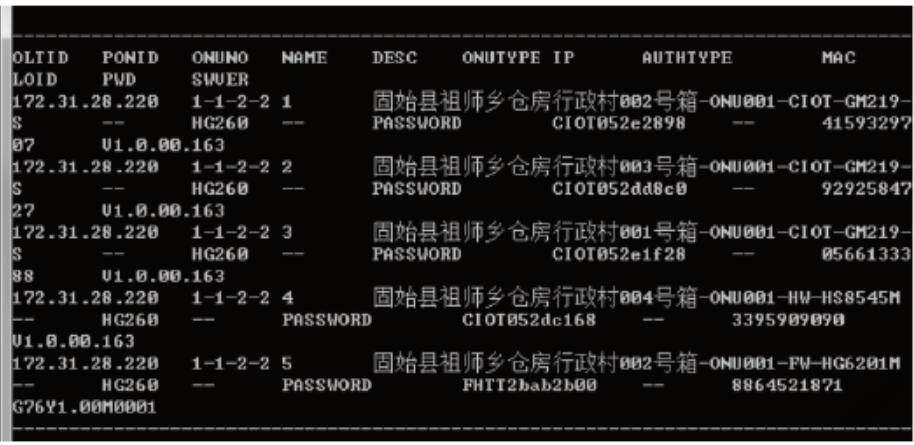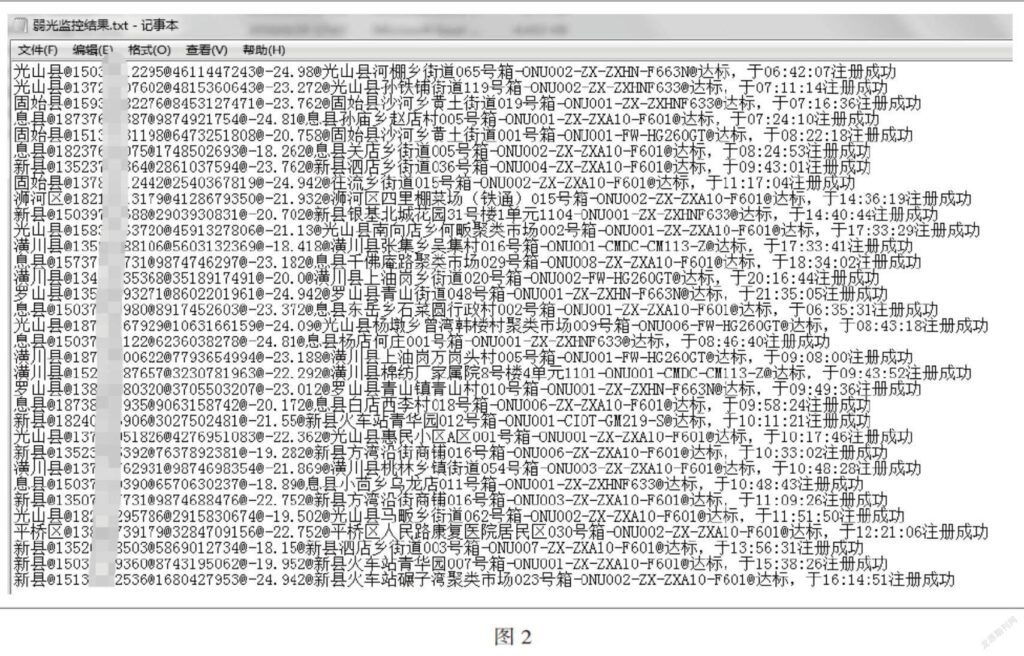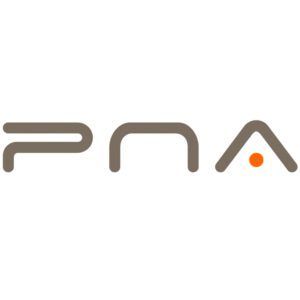[Abstract] Wired broadband users often network through FTTH or FTTB technology. From the user-side ONU optical cat terminal, they finally connect to OLT equipment through optical fiber, optical splitter, fiber distribution box, optical exchange box and other equipment, and then access to the metropolitan area network backbone router BRAS through OLT up. For Internet access, the ONU optical power value is an important indicator to measure the user’s Internet quality perception. For the optical power value below -27db, it belongs to weak light. ONU power low light seriously affects the user’s Internet experience perception. Therefore, the rectification of weak light ONU is the wired broadband end-to-end network quality and It is an important work to improve customer satisfaction, but there are many factors that affect weak light, and there are often many difficulties in the rectification practice. This article is to actively explore the difficult problems encountered in practice, summarize experience, and finally find a set of efficient and easy-to-implement solutions.
I. Current situation and innovative ideas
According to the work requirements for improving the satisfaction of the group’s users and the relevant work deployment of the provincial company, PNA Mobile Company has carried out a special rectification activity of Jiake Weak Light ONU. Since the launch of this activity in July 2019, we have encountered many difficulties, mainly in the following aspects:
1. When sorting out the low-light list of the whole network, it is necessary to manually and regularly export the weak-light report from the OLT network management. It is impossible to collect it in real time, and there will be a big deviation in statistics. The light cat ONU light failure index is a dynamic change. According to the rectification task list, the installation and maintenance contact the user for door-to-door processing. There are some network management statistics on weak light, but the actual light failure in the light cat is normal, resulting in the useless work of the installation and maintenance personnel, wasting time and low efficiency.
2. The weak light report extracted through the network management cannot reflect the specific location section that causes the weak light, and cannot qualitatively judge the cause of low light, and divide the main responsibility for maintenance. The reasons for weak light are divided according to the location. The main three location sections are: organic room to optical delivery box (main trunk section), optical delivery box to fiber distribution box (branch section), and fiber distribution box to user (user segment). The main responsibility for maintenance of different location sections is different, and it is often handled by different maintenance units and personnel, so low light regulation is required. Multiple maintenance subjects need to cooperate with each other and rectify together. In practice, we often require all home and customer installation and maintenance personnel to fully investigate the cause of weak light from the user segment. For problems that do not belong to the user segment, report to the background support, and the branch maintenance unit will be notified to investigate the reason after the background support is collected by the background support. There is no problem in the branch segment. Then the background support will notify the main body of the backbone to check and deal with. This kind of segmented investigation method often has different maintenance subjects shirk each other, which eventually leads to some weak light delay and not being dealt with in time.
3. After the on-site rectification, it is often necessary to contact the background support personnel to check the latest light failure from the network management, and verify and confirm the rectification effect, which increases the pressure and bottleneck of the background support, and the work efficiency is very low.
4. In addition, when the installation and maintenance personnel come to the door to investigate and deal with the weak light, they often encounter situations that some users do not understand and do not cooperate, and even think that some installation and maintenance personnel are liars, and refuse to come to the door to check the performance status of the light cat for a physical examination, resulting in the inability to deal with the low light.
In view of the problems encountered in the above weak light rectification practice, we independently write programs according to the relevant interfaces provided by the OLT network management, use the program call interface to obtain the relevant low-light ONU original data, and then the program processes, analyzes and processes the original data, and finally develops a low-light rapid identification and automatic monitoring system. The unified tool greatly improves the efficiency of weak light regulation.
II. Implementation content
Step 1: You need to be familiar with the use of relevant OLT interfaces and configuration management instructions.
The collection of low-light ONU original data requires the OLT network administrator to provide relevant management interfaces, and there are two main types:
1. Northbound interface
The northbound interface is an interface defined for users to access and manage the network. It is necessary to configure the northbound interface service process on the OLT network management server and present it to the operator in the form of a simple, easy-to-use and intuitive interface. The operator clicks or configures the interface to send northbound commands, and the northbound service process follows these commands. The transformation of the specification into OLT can identify the received instructions and send them to the OLT to execute and return the result work operator for subsequent processing.
2. Telnet interface
OLT’s remote login management interface. The operator accesses the telnet remote service port of OLT through the specific network with credit. After successful login, the relevant control management instructions are issued to OLT. After the execution of OLT, the relevant results are returned for the operator for subsequent processing.
These two interfaces have their own advantages and disadvantages. The north-facing interface requires the network management server to turn on the north-facing process function and occupy the network management server resources. If a large number of control instructions need to be issued, it will often cause the server performance to slow down, or even be paralyzed to provide services. There is a performance bottleneck. The telnet interface can be scattered alone. Send control instructions to OLT, but it has high requirements for the performance and specific configuration of the network. The low-light rapid identification and automatic monitoring tools developed in this paper combine different practical needs and make comprehensive use of these two interface functions. Mainly use the following instructions: LST-BOARD:: OLTID=172.31.22.36: CTAG:; // query the board information of an OLT
LST-ONU:: OLTID=172.31.28.220, PONID=1-1-2-02: CTAG:; // Query the user’s light cat information under a specific PON port under the specified OLT
LST-OMDDM:: OLTID=172.31.28.220, PONID=1-1-2-02: CTAG:: ;// Query the light decay information of all light cats under a specific PON port under a specific OLT.
LST-PORTVLAN:: OLTID=172.31.22.84, PONID=1-1-3-3, ONUIDTYPE=PASSWORD, ONUID=8528880529, ONUPORT=NA-NA-NA- 1: CTAG::; // Query the light decay of a specific light cat.
LST-ONUSTATE:: OLTID=172.31.22.84, PONID=1-1-3-3, ONUIDTYPE=PASSWORD, ONUID=8528880529: CTAG:; //Query a certain light cat Current online status
LST-PORTVLAN:: OLTID=172.31.22.84, PONID=1-1-1-6, ONUIDTYPE=PASSWORD, ONUID=0227243835, ONUPORT=NA-NA-NA- 1: CTAG::; // Query a certain light cat vlan business information
ADD-PONVLAN:: OLTID=172.31.23.148, PONID=1-111-08, ONUIDTYPE=PASSWORD, ONUID=2380621765: CTAG:: SVLAN=307 2, CVLAN=18, UV=4031, SCOS=0, CCOS=0; // Add light cat business VLAN information
DEL-PONVLAN:: OLTID=172.31.24.60, PONID=1-1-1-05, ONUIDTYPE=PASSWORD, ONUID=4004329689: CTAG:: UV=4031; // Delete the business VLAN information of Light Cat.
The screenshot of the results returned by some key instructions through the north-facing interface is as follows:
The following instructions are required through the telnet interface.
show card // check the board information
show run intface gpon-olt_1/2/1 // query the specific configuration information of a PON port of OLT
show run intface gpon-onu_1/2/1: 5 // Query the specific configuration information of an OLT light cat
show interface optical-module-info gpon-olt_1/2/1 View the light decay information of OLT PON port
show pon power onu-rx gpon-onu_1/2/1:1 //Query the light decay information of a light cat under OLT
Step 2: Write the program
This proposal is based on the java object-oriented programming language and uses the eclipse integrated development environment for deployment and development. The program project mainly encapsulates ONU, ZXOLT, FHOLT, Telnet, NorthInterface, ONUFile and other object classes. Each object class encapsulates the execution process functions of various action commands.
ONU class: used to instance the specific attributes of each ONU, such as attribution to OLT, attribution to the county, activation code, attribution to PON port, SVLAN, CVLAN and other configuration information, etc.
ZXOLT, FHOLT class: a specific example of an OLT. Since we have the OLT equipment of ZTE and Fenfire, the OLT of different manufacturers has great differences in business implementation details. Therefore, according to the actual situation, the program encapsulates different OLT classes separately for example OLT. Specific attributes, such as OLT management IP, northward or telent interface login account and password, and many methods are also implemented in such as batch query of light cat light decay, batch query light cat status, batch deletion of optical cat Internet VLAN, batch addition of optical cat Internet VLAN
Qualitative analysis of weak light ONU causes, low light ONU automatic monitoring, etc.
Telnet and NorthInterface classes: These two encapsulation classes are mainly used to issue configuration instructions to OLT through telnet or north-facing interfaces and return execution results. ( The specific implementation is called the relevant function method in the commons-net-2.0.jar plug-in opened by Aaphce. This plug-in can be downloaded for free on the Internet, which is not the original of this project.
ONUfile class: File processing is related, and the asset management system interface needs to be called to provide the original startup data for program execution, and convert the results generated by the program into relevant reports.
Some basic frameworks of the program are described above, and the core algorithms used by the program are described below.
Weak light rapid recognition algorithm steps:
1. First specify an OLT management IP, log in to the specified OLT through telnet or north-facing interface, and then query how many business boards there are in this OLT and the type of each business board (8 or 16 boards).
2. Calculate all available PON ports of OLT.
3. Query the number of ONU under the specified single PON port, and then cycle back the online status and light decay of each ONU, and then make the following judgment through the program. The light cat is online and the light weak at -25db belongs to the weak light ONU. Output this ONU related information, and the light cat is not online or the online light decay. The subject matter jumps out directly. After a PON port is processed, it returns to step 2 to execute all PON ports.
4. After an OLT query is completed, return to step 1 and execute all OLTs in a loop.
Through the three-layer loop, the program can finally output all the low-light ONU information of all OLTs on the whole network.
Qualitative analysis algorithm for low light causes:
Specify a weak light ONU information, obtain the information of ONU’s ownership of OLT and PON port, log in to OLT through telnet or north-facing interface, then query all ONU weak light under the same PON port, and then calculate the proportion of weak light under the PON port, and the proportion of weak light is greater than the characterization of “parameter 1” as the main trunk. If the proportion of weak light is lower than “Parameter 1”, then calculate the proportion of other ONU light attenutument with the same box number with the specified ONU. If the proportion of weak light in the same box number is higher than “Parameter 2” is characterized as a branch problem, if the above situation is not characterized as a user segment problem. ( Because the number of different PON mouth light cats is different, and some light cats are offline when querying, resulting in a deviation in the target, the program will float the parameters set above in the specific implementation. In practice, parameter 1 is set to 40%-70%, and parameter 2 is set to 30%-60. %, divided into multiple sampling calculations, and finally take the qualitative analysis results with the highest probability for judgment and output)
Automatic monitoring algorithm for low light:
Obtain the low-light ONU list through the low-light automatic recognition algorithm. The program then loops up each ONU in the list according to the list. The low-light ONU that does not meet the standard issues management instructions through the telent or north-facing interface (such as deleting the optical cat Internet service VLAN or port shutdown) To enable, so that the light cat will not be able to access the Internet), the light decay to regulate the standard ONU, and then issue management instructions through the interface (such as adding the light cat Internet service VLAN or port undo shutdown recovery port enablement, so that the light cat Internet function can be restored). After the list cycle is completed, then set A fixed pause interval (during the suspension period, the program will carry out the relevant low-light ONU status, list report calculation and update and other subsequent closing work). After the pause time, the program will carry out a circular query, so that the purpose of automatic monitoring can be achieved.
When the automatic monitoring function of the program is turned on, it will cause users to be unable to access the Internet, which will inevitably increase the risk of user complaints. Therefore, in practice, the practice we explore is to turn on automatic monitoring on the new ONU generated by the network management in the same month or the same day. Once the program scan query finds that the light failure is not up to the standard, it will be turned on automatically. Force the installation and maintenance personnel to immediately carry out on-site investigation and correction. After the light failure reaches the standard, the program will automatically resume the Internet, so as to control the weak light ONU from the source to enter the network. For the stock, if the installation and maintenance personnel actively contact the user for a door-to-door light cat physical examination, the user does not understand, and the low-light users who do not cooperate will be fed back to the background by the installation and maintenance. After the background collection, a mandatory rectification list is formed, and then the program only turns on automatic monitoring for the weak-light users in the forced rectification list, which belongs to the backbone or branch problem. The monitoring function is no longer enabled for low-light users.
According to the above various encapsulation classes and algorithm ideas, the development of the project tool is finally completed. The main interface of the tool is shown in Figure 1 below.


The low-light ONU automatic monitoring results (saved in the form of a text file, if the amount of data is large, it can be stored in SQL database) in order to quantitatively evaluate the maintenance company. As shown in Figure 2 below.


III. Concluding remarks
Previously, when installing and maintaining the on-site rectification of weak light, it was often necessary to call the background support phone to query and confirm the latest rectification results from the network management. On average, the background needed to answer more than 100 inquiry calls every day, which increased the workload of background support personnel. This project program realizes the automatic monitoring function and only requires a small amount of background support resources. It can meet the demand and greatly reduce the background support pressure. In addition, before, the latest light decay of ONU was manually queryed from the network management to determine whether the weak light rectification was up to the standard. The query efficiency was extremely low. According to statistics, it took an average of 40 minutes to manually query 100 weak light ONUs, and the process was used to pass the process. It only takes an average of 1 minute to query 100 weak light in single-task single-threaded mode. Obviously, the efficiency of low-light query through this project program will be greatly improved.
PNA Mobile Company adopted the low-light rectification solution proposed in this article to carry out weak-light rectification, and has achieved remarkable results in practice. From July 2019 to July 2021, we have rectified a total of nearly 100,000 low-light ONUs, including 1,502 main problems and branch problems. In 6097 places, the proportion of total low light gradually decreased from 3.8% to 0.96%. In terms of the cause of user complaints, the proportion of complaints caused by slow network speed and stuck viewing set-top boxes decreased from 40% to less than 10%.

